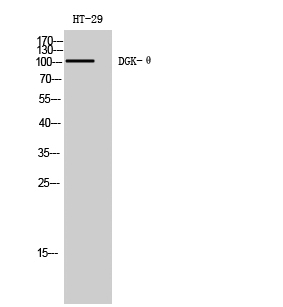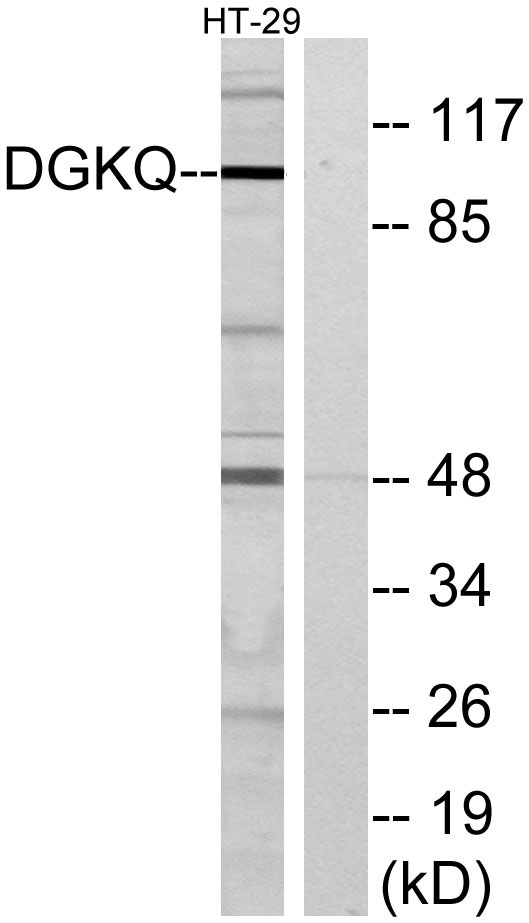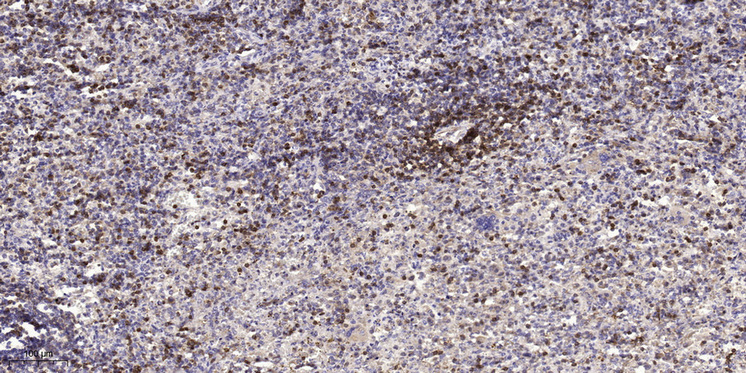DGK-θ Polyclonal Antibody
- Catalog No.:YT1337
- Applications:WB;IHC;IF;ELISA
- Reactivity:Human;Rat;Mouse;
- Target:
- DGK-θ
- Fields:
- >>Glycerolipid metabolism;>>Glycerophospholipid metabolism;>>Metabolic pathways;>>Phosphatidylinositol signaling system;>>Phospholipase D signaling pathway;>>Choline metabolism in cancer
- Gene Name:
- DGKQ
- Protein Name:
- Diacylglycerol kinase theta
- Human Gene Id:
- 1609
- Human Swiss Prot No:
- P52824
- Mouse Swiss Prot No:
- Q6P5E8
- Immunogen:
- The antiserum was produced against synthesized peptide derived from human DGKQ. AA range:691-740
- Specificity:
- DGK-θ Polyclonal Antibody detects endogenous levels of DGK-θ protein.
- Formulation:
- Liquid in PBS containing 50% glycerol, 0.5% BSA and 0.02% sodium azide.
- Source:
- Polyclonal, Rabbit,IgG
- Dilution:
- WB 1:500 - 1:2000. IHC 1:100 - 1:300. ELISA: 1:10000.. IF 1:50-200
- Purification:
- The antibody was affinity-purified from rabbit antiserum by affinity-chromatography using epitope-specific immunogen.
- Concentration:
- 1 mg/ml
- Storage Stability:
- -15°C to -25°C/1 year(Do not lower than -25°C)
- Other Name:
- DGKQ;DAGK4;Diacylglycerol kinase theta;DAG kinase theta;Diglyceride kinase theta;DGK-theta
- Observed Band(KD):
- 101kD
- Background:
- The protein encoded by this gene contains three cysteine-rich domains, a proline-rich region, and a pleckstrin homology domain with an overlapping Ras-associating domain. It is localized in the speckle domains of the nucleus, and mediates the regeneration of phosphatidylinositol (PI) from diacylglycerol in the PI-cycle during cell signal transduction. [provided by RefSeq, Jul 2008],
- Function:
- catalytic activity:ATP + 1,2-diacylglycerol = ADP + 1,2-diacyl-sn-glycerol 3-phosphate.,similarity:Belongs to the eukaryotic diacylglycerol kinase family.,similarity:Contains 1 DAGKc domain.,similarity:Contains 1 Ras-associating domain.,similarity:Contains 3 phorbol-ester/DAG-type zinc fingers.,
- Subcellular Location:
- Cytoplasm . Cytoplasm, cytosol . Cell membrane . Cell junction, synapse . Cytoplasm, cytoskeleton . Nucleus . Nucleus speckle . Nucleus matrix . Translocates to the plasma membrane in response to steroid hormone receptor stimulation (PubMed:15632189). Translocation to the plasma membrane is dependent on G-protein coupled receptor stimulation and subsequent activation of PRKCE and probably PRKCH (PubMed:15632189). Translocates to the nucleus in response to thrombin stimulation (Probable). Association with the nuclear matrix is regulated by nerve growth factor (By similarity). .
- Expression:
- Brain,
- June 19-2018
- WESTERN IMMUNOBLOTTING PROTOCOL
- June 19-2018
- IMMUNOHISTOCHEMISTRY-PARAFFIN PROTOCOL
- June 19-2018
- IMMUNOFLUORESCENCE PROTOCOL
- September 08-2020
- FLOW-CYTOMEYRT-PROTOCOL
- May 20-2022
- Cell-Based ELISA│解您多样本WB检测之困扰
- July 13-2018
- CELL-BASED-ELISA-PROTOCOL-FOR-ACETYL-PROTEIN
- July 13-2018
- CELL-BASED-ELISA-PROTOCOL-FOR-PHOSPHO-PROTEIN
- July 13-2018
- Antibody-FAQs
- Products Images

- Western Blot analysis of HT-29 cells using DGK-θ Polyclonal Antibody

- Western blot analysis of lysates from HT-29 cells, using DGKQ Antibody. The lane on the right is blocked with the synthesized peptide.

- Immunohistochemical analysis of paraffin-embedded human spleen tissue. 1,primary Antibody was diluted at 1:200(4° overnight). 2, Sodium citrate pH 6.0 was used for antigen retrieval(>98°C,20min). 3,Secondary antibody was diluted at 1:200



